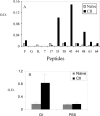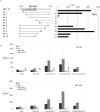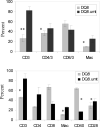B cells are important as antigen presenting cells for induction of MHC-restricted arthritis in transgenic mice
- PMID: 17303243
- PMCID: PMC1995074
- DOI: 10.1016/j.molimm.2006.12.026
B cells are important as antigen presenting cells for induction of MHC-restricted arthritis in transgenic mice
Abstract
Rheumatoid arthritis and its animal model, collagen-induced arthritis, are known as a T and B cell dependent disease. To analyze the role of B cells in arthritis, we generated B cell deficient (microMT) mice carrying HLA-DQ8 as transgene, Abetao.DQ8.micromt mice. HLA-DQ8 transgenic mice (Abetao.DQ8) are susceptible to collagen induced arthritis, an animal model for inflammatory arthritis. Deletion of IgM gene led to the absence of B cells while T cells were comparable to Abetao.DQ8 mice. Arthritis and autoantibodies was completely abrogated in B cell deficient DQ8 mice. T cell response and proinflammatory cytokine production in response to type II collagen and its derived peptides in vitro was significantly decreased despite an increased number of Mac-1 positive cells in DQ8.micromt mice compared to DQ8 mice suggesting B cells could be important for antigen presentation as well. In vitro substitution of B cells from wild type mice restored the response in DQ8.micromt mice. B cells could also present CII-derived peptides to antigen-specific DQ8-restricted hybridomas reinforcing the role of B cells in presentation of antigens to T cells. The data suggest that B cells can be involved in pathogenesis of arthritis by producing autoantibodies and antigen presentation.
Figures






References
-
- Amigorena S, Salamero J, Davoust J, Fridman WH, Bonnerot C. Tyrosine-containing motif that transduces cell activation signals also determines internalization and antigen presentation via type III receptors for IgG. Nature. 1992;358:337–41. - PubMed
-
- Baird AM, Parker DC. Analysis of low zone tolerance induction in normal and B-cell deficient mice. J Immunol. 1996;157:1833–39. - PubMed
-
- Bazzoni F, Beutler B. The tumor necrosis factor ligand and receptor families. N Engl J Med. 1996;334:1717–25. - PubMed
Publication types
MeSH terms
Substances
Grants and funding
LinkOut - more resources
Full Text Sources
Molecular Biology Databases
Research Materials

